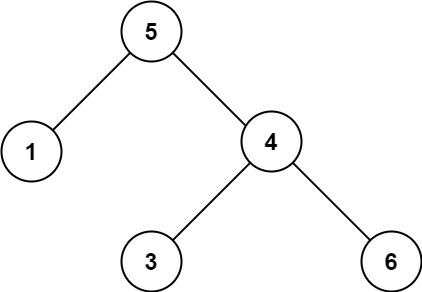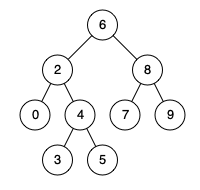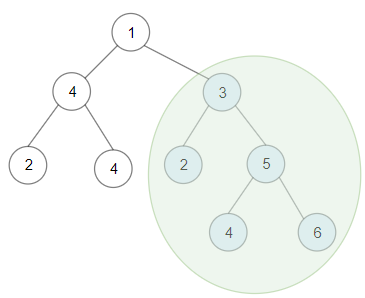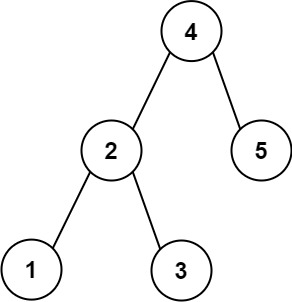Binary Search Tree
1. Introduction
Binary search tree(BST, 二叉搜索树)是一种binary tree(二叉树)的树型数据结构, 定义如下:
- 若BST的左子树不为空, 则其左子树上所有节点的权值均小于其根节点的权值
- 若BST的右子树不为空, 则其右子树上所有节点的权值均小于其根节点的权值
- BST的左右子树均为BST
- 空树也是BST
1.1 BST Traversal
BST的inorder traversal(中序遍历)的序列为非降序序列, 时间复杂度为$O(n)$(BST的节点数为n)
1.2 Minimum and Maximum
由BST的性质可得, BST左链的顶点为最小值, 右链的顶点为最大值, 时间复杂度为$O(n)$(BST的节点数为n)
1.3 Insert an Element
假设BST的根节点为o, 插入的新节点值为v, 则插入元素时分为以下几种情况:
- 若
o为空, 直接返回值为v的新节点 - 若
o的权值等于v, 则不添加新的节点 - 若
o的权值大于v, 则在o的左子树插入权值为v的节点 - 若
o的权值小于v, 则在o的右子树插入权值为v的节点
1.4 Delete an Element
假设BST的根节点为o, 删除一个值为v的节点, 首先需要在BST中找到权值为v的节点:
- 若
o为空, 则BST中不存在权值为v的节点, 无需删除 - 若
o的权值等于v, 则删除当前节点o - 若
o的权值大于v, 则在o的左子树删除权值为v的节点 - 若
o的权值小于v, 则在o的右子树删除权值为v的节点
2. Implementation
2.1 Query Element
查找元素时, 只需根据情况判断需向左子树或右子树走, 每次判断都会缩小查找范围, 从而提高查找效率. 假设目标值为val, 从根节点出发:
- 若当前节点为空, 则查找失败
- 若当前节点不为空, 对比节点值与目标值
- 若$val = node.val$, 则查找成功
- 若$val < node.val$, 则查找左子树
- 若$val > node.val$, 则查找右子树
最好的情况下, BST与二分查找类似, 从根节点到叶子节点的高度为$\log_2 n$, 因此时间复杂度为$O(\log_2 n)$; 最坏情况下, BST会变为一个链表, 即只有左子树或右子树, 退化为顺序查找, 因此时间复杂度为$O(n)$.
2.2 Insert Element
插入操作与查找操作的步骤类似, 假设插入值为val, 从根节点出发:
- 若当前节点为空, 则创建一个值为
val的节点 - 若当前节点不为空, 比较节点值和插入值:
- 若$val < node.val$, 则插入左子树
- 若$val > node.val$, 则插入右子树
由于BST不允许重复节点, 因此若插入值已存在于BST中, 则直接返回.
2.3 Delete Element
在BST中删除元素需先找到被删除节点, 再执行删除操作. 被删除节点可分为三种情况:
- 被删除节点的左子树为空, 则让右子树代替被删除节点
- 被删除节点的右子树为空, 则让左子树代替被删除节点
- 被删除节点的左右子树均不为空, 则让immediate predecessor/successor(直接前驱或直接后继, 也就是小于被删除节点值的最大值, 或大于被删除节点值的最小值)代替被删除节点
BST删除元素的步骤如下, 从根节点出发:
- 若当前元素为空, 则返回空
- 若$val < node.val$, 则从左子树搜索并删除, 之后更新
node.left - 若$val > node.val$, 则从右子树搜索并删除, 之后更新
node.right - 若$val = node.val$, 则当前节点为被删除节点:
- 若当前节点的左子树为空, 则让右子树代替当前节点, 返回右子树
- 若当前节点的右子树为空, 则让右子树代替当前节点, 返回左子树
- 若当前节点的左右子树均不为空, 则将左子树转移到右子树最左侧叶子节点的位置上, 并让右子树代替当前节点, 返回右子树
3. Leetcode
95. Unique Binary Search Trees II
Problem Description
Given an integer n, return all the structurally unique BST's (binary search trees), which has exactly n nodes of unique values from 1 to n. Return the answer in any order.
Example 1:
Input: n = 3 |
Solution
class Solution { |
98. Validate Binary Search Tree
Problem Description
Given the root of a binary tree, determine if it is a valid binary search tree (BST).
A valid BST is defined as follows:
- The left subtree of a node contains only nodes with keys less than the node's key.
- The right subtree of a node contains only nodes with keys greater than the node's key.
- Both the left and right subtrees must also be binary search trees.
Example 1:
Input: root = [5,1,4,null,null,3,6] |
Solution
class Solution { |
669. Trim a Binary Search Tree
Problem Description
Given the root of a binary search tree and the lowest and highest boundaries as low and high, trim the tree so that all its elements lies in [low, high]. Trimming the tree should not change the relative structure of the elements that will remain in the tree (i.e., any node's descendant should remain a descendant). It can be proven that there is a unique answer.
Return the root of the trimmed binary search tree. Note that the root may change depending on the given bounds.
Example 1:
Input: root = [1,0,2], low = 1, high = 2 |
Solution
class Solution { |
235. Lowest Common Ancestor of a Binary Search Tree
Problem Description
Given a binary search tree (BST), find the lowest common ancestor (LCA) node of two given nodes in the BST.
According to the definition of LCA on Wikipedia: "The lowest common ancestor is defined between two nodes p and q as the lowest node in T that has both p and q as descendants (where we allow a node to be a descendant of itself)."
Example 1:
Input: root = [6,2,8,0,4,7,9,null,null,3,5], p = 2, q = 8 |
Solution
class Solution { |
450. Delete Node in a BST
Problem Description
Given a root node reference of a BST and a key, delete the node with the given key in the BST. Return the root node reference (possibly updated) of the BST.
Basically, the deletion can be divided into two stages:
- Search for a node to remove.
- If the node is found, delete the node.
Example 1:
Input: root = [5,3,6,2,4,null,7], key = 3 |
Solution
class Solution { |
230. Kth Smallest Element in a BST
Problem Description
Given the root of a binary search tree, and an integer k, return the $k^{th}$ smallest value (1-indexed) of all the values of the nodes in the tree.
Example 1:
Input: root = [5,3,6,2,4,null,null,1], k = 3 |
Solution
class Solution { |
1373. Maximum Sum BST in Binary Tree
Problem Description
Given a binary tree root, return the maximum sum of all keys of any sub-tree which is also a Binary Search Tree (BST).
Assume a BST is defined as follows:
- The left subtree of a node contains only nodes with keys less than the node's key.
- The right subtree of a node contains only nodes with keys greater than the node's key.
- Both the left and right subtrees must also be binary search trees.
Example 1:
Input: root = [1,4,3,2,4,2,5,null,null,null,null,null,null,4,6] |
Solution
class Solution { |
272. Closest Binary Search Tree Value II
Problem Description
Given the root of a binary search tree, a target value, and an integer k, return the k values in the BST that are closest to the target. You may return the answer in any order.
You are guaranteed to have only one unique set of k values in the BST that are closest to the target.
Example 1:
Input: root = [4,2,5,1,3], target = 3.714286, k = 2 |
Solution
class Solution { |